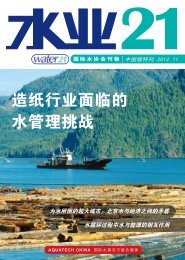PUBLICATIONS CATALOGUE 2012 - IWA Publishing
PUBLICATIONS CATALOGUE 2012 - IWA Publishing
PUBLICATIONS CATALOGUE 2012 - IWA Publishing
Create successful ePaper yourself
Turn your PDF publications into a flip-book with our unique Google optimized e-Paper software.
N E W P U B L I C A T I O N S 2 0 1 2<br />
and maintenance), simple to operate, proven technologies, is a<br />
key component in any strategy aimed at increasing the<br />
coverage of wastewater treatment.<br />
Sustainable Treatment and Reuse of Municipal Wastewater<br />
presents the concepts of appropriate technology for<br />
wastewater treatment and the issues of strategy and policy<br />
for increasing wastewater treatment coverage. The book<br />
focuses on the resolution of wastewater treatment and disposal<br />
problems in developing countries, however the concepts<br />
presented are valid and applicable anywhere and plants based<br />
on combined unit processes of appropriate technology can<br />
also be used in developed countries and provide to them the<br />
benefits described.<br />
Sustainable Treatment and Reuse of Municipal Wastewater<br />
presents the basic engineering design procedures to obtain<br />
high quality effluents by treatment plants based on simple, low<br />
cost and easy to operate processes. The main message of<br />
the book is the idea of the ability to combine unit processes<br />
to create a treatment plant based on a series of appropriate<br />
technology processes which jointly can generate any required<br />
effluent quality.<br />
A plant based on a combination of appropriate technology<br />
unit processes is still easy to operate and is usually of lower<br />
costs than conventional processes in terms of investment and<br />
certainly in operation and maintenance.<br />
Chapters in the book are organized in a practical and accessible<br />
way to:<br />
• demonstrate selected unit process of appropriate technology<br />
and provide the scientific basis, the equations and the<br />
parameters required to design the unit processes, with some<br />
innovations developed by the authors.<br />
• highlight design procedures for selected combined processes<br />
which are in use in developing countries.<br />
• propose an innovative Orderly Design Method (ODM),<br />
which is easy to follow by practicing engineers, using the<br />
equations and formulas developed, once the fundamentals of<br />
each unit and combined process have been established.<br />
• provide a numeric example for the basic design of each<br />
selected appropriate technology process for a city with a<br />
population of 20,000 using the ODM and an Excel program<br />
which will be provided to the readers for download from an<br />
online web page.<br />
This book is a valuable and practical resource for all wastewater<br />
treatment engineers in field and the operational managers of<br />
waste treatment facilities.<br />
Contents:<br />
• Appropriate Technologies for Treatment of Municipal<br />
Wastewater<br />
• Decomposition Processes of Organic Matter<br />
• Calculation of Wastewater Flow and BOD Load<br />
• Rotating Microscreens – RM<br />
• Treatment in Stabilization Lagoons<br />
• Anaerobic Treatment<br />
• Stabilization Reservoirs<br />
• Horizontal Flow Constructed Wetland<br />
• Chemically Enhanced Primary Treatment (CEPT)<br />
• Complementary Processes to Combine with Appropriate<br />
Technology Processes<br />
• Combinations of Appropriate Technology Processes<br />
• Potential of Generation of Energy in Wastewater Treatment<br />
Plants<br />
• Global Warming and Climatic Impact of Wastewater<br />
Treatment<br />
March <strong>2012</strong> • 384 pages • Paperback<br />
ISBN: 9781780400167 • Ebook ISBN: 9781780400631*<br />
<strong>IWA</strong> Members Price: £71.25/US$128.25/e96.19<br />
Non Members Price: £95.00/US$171.00/e128.25<br />
Water & Wastewater Treatment<br />
Chemistry of Ozone in Water and<br />
Wastewater Treatment<br />
From Basic Principles to Applications<br />
Authors: Clemens von Sonntag<br />
and Urs von Gunten<br />
Even though ozone has been applied for<br />
a long time for disinfection and oxidation<br />
in water treatment, there is lack of<br />
critical information related to<br />
transformation of organic compounds.<br />
This has become more important in<br />
recent years, because there is<br />
considerable concern about the<br />
formation of potentially harmful<br />
degradation products as well as<br />
oxidation products from the reaction<br />
with the matrix components. In recent years, a wealth of<br />
information on the products that are formed has accumulated,<br />
and substantial progress in understanding mechanistic details of<br />
ozone reactions in aqueous solution has been made. Based on<br />
the latter, this may allow us to predict the products of as yet<br />
not studied systems and assist in evaluating toxic potentials in<br />
case certain classes are known to show such effects. Keeping<br />
this in mind, Chemistry of Ozone in Water and Wastewater<br />
Treatment: From Basic Principles to Applications will discuss<br />
mechanistic details of ozone reactions as much as they are<br />
known to date and apply them to the large body of studies on<br />
micropollutant degradation such as pharmaceuticals and<br />
endocrine disruptors that is already available. Extensively<br />
quoting the literature and updating the available compilation of<br />
ozone rate constants will give the reader a text at hand on<br />
which his research can be based. Moreover, those that are<br />
responsible for planning or operation of ozonation steps in<br />
drinking water and wastewater treatment plants will find salient<br />
information in a compact form that otherwise is quite disperse.<br />
A critical compilation of rate constants for the various classes<br />
of compounds is given in each chapter, including all the recent<br />
publications. This is a very useful source of information for<br />
researchers and practitioners who need kinetic information on<br />
emerging contaminants. Furthermore, each chapter contains<br />
a large selection of examples of reaction mechanisms for the<br />
transformation of micropollutants such as pharmaceuticals,<br />
pesticides, fuel additives, solvents, taste and odor compounds,<br />
cyanotoxins.<br />
Contents:<br />
• Historical background and introduction to the scope of the<br />
book<br />
• Properties of ozone – UV-spectrum – Solubility in water –<br />
Determination of its concentration in water – Determination<br />
of ozone uptake in a bubble column – Stability of ozone in<br />
water – Production of ozone – Cost of ozone generation for<br />
technical applications<br />
• Integration of ozonation in drinking water and wastewater<br />
process trains – Pre- and post-treatment with ozone<br />
– Ozonation as polishing treatment in wastewater –<br />
Combination of ozone with biological processes in drinking<br />
water and wastewater<br />
• Ozone decay kinetics in water and wastewater – Role of<br />
water matrix components – The •OH radical yield in the<br />
reaction of ozone with organic matter, reaction of ozone<br />
with hydrogen peroxide−(DOM) – decomposition of<br />
ozone by OH (peroxone process) – kinetics and mechanistic<br />
concepts –– modelling of ozonation in drinking water and<br />
wastewater. Ozone-based AOPs: O3/H2O2, UV/O3, O3/<br />
activated carbon<br />
• Disinfection by ozone – Efficiency for inactivation of bacteria,<br />
viruses and protozoa- Mechanisms of disinfection – Reactions<br />
of ozone with nucleic acid components<br />
• Disinfection by-products (DBPs): Bromate, brominated<br />
organic compounds, iodate, NDMA, assimilable organic<br />
carbon – Kinetics and mechanisms – Mitigation options for<br />
DBP minimization – Ozonation as DBP control option for<br />
post-chlorination processes<br />
• Ozone kinetics – Methods for measuring ozone kinetics –<br />
Reactivity of ozone – Consequences of the electrophilicity<br />
concept – Quantum chemical calculations – Competition<br />
kinetics – pH dependence of ozone reactions – Multiple<br />
reaction sites within one molecule and the “reactivity pK”<br />
• Reactions of ozone with olefins and the Criegee mechanism<br />
– Characterization of hydroxyalkylhydroperoxides as<br />
intermediates and their decay routes<br />
• Reactions of ozone with aromatic compounds – Muconic<br />
products (Criegee mechanism) – Hydroxylation and the<br />
release of singlet oxygen – Formation of •OH radicals<br />
• Reactions of ozone with amines – O-transfer and singlet<br />
oxygen formation – Formation of •OH radicals<br />
• Reactions of sulfur-containing compounds – Thiols – Sulfides<br />
and disulfides – Sulfoxides and sulfinic acids<br />
• Reactions of ozone with free radicals – Carbon-centred<br />
radicals – •H atom – – •OH – Nitroxyl radicals – Peroxyl<br />
radicals – Aminyl radicals – Thiyl−HO2•/O2• radicals –<br />
Halogen-derived radicals<br />
• Reactions with transition metals and metalloids – Iron(II) –<br />
Manganese(II) – Arsenic(III)<br />
• Reactions with inorganic ions – Chloride – Hypochlorite<br />
– Chlorite – Bromide – Hypobromite – Bromite – Iodide –<br />
Nitrite – Azide – Hydrogen sulfide<br />
• Reactions of ozone with aliphatic compounds<br />
• Reactions of •OH radicals – Addition to double bonds<br />
– H-abstraction reactions–Electron transfer reactions –<br />
Determination of •OH rate constants – Detection of •OH<br />
radicals in ozone reactions (drinking water and wastewater)<br />
–Quantification of the •OH yield in wastewater ozonation –<br />
Kinetics of •OH reactions –Degradation of ozone-refractory<br />
compounds in wastewater by •OH radicals– Formation of<br />
peroxyl radicals<br />
• eliminations –−Reactions of peroxyl radicals – Bimolecular<br />
decay – HO2•/O2• Formation of oxyl radicals and their<br />
reactions<br />
May <strong>2012</strong> • 350 pages • Hardback<br />
ISBN: 9781843393139 • Ebook ISBN: 9781780400839*<br />
<strong>IWA</strong> Members Price: £74.25/US$133.65/e100.24<br />
Non Members Price: £99.00/US$178.20/e133.65<br />
Student Price: £59.00/US$106.20/e79.65<br />
Water & Wastewater Treatment<br />
Wastewater Treatment:<br />
Advanced Processes and<br />
Technologies<br />
Editors: D G Rao, R Senthikumar, J Anthony Byrne,<br />
S Feroz<br />
Emphasizing new technologies that<br />
produce clean water and energy from<br />
the wastewater treatment process,<br />
Wastewater Treatment: Advanced<br />
Processes and Technologies presents<br />
recent advancements in wastewater<br />
treatment by various technologies such<br />
as chemical methods, biochemical<br />
methods, membrane separation<br />
techniques, and nanotechnology. It<br />
addresses sustainable water reclamation,<br />
biomembrane treatment processes, advanced oxidation<br />
processes, and applications of nanotechnology for wastewater<br />
treatment. It also includes integrated cost-based design<br />
methodologies. Equations, figures, photographs and tables are<br />
included within the chapters to aid reader comprehension.<br />
Case studies and examples are included as well.<br />
Features:<br />
• Covers emerging applications of nanotechnology for<br />
wastewater treatment<br />
• Includes integrated cost-based design methodologies<br />
* For Ebook Prices please see page 2<br />
F o r m o r e i n f o r m a t i o n a n d t o b u y o n l i n e g o t o<br />
w w w . i w a p u b l i s h i n g . c o m<br />
23

















